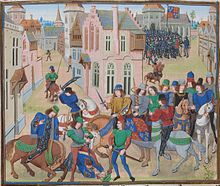Sir William Walworth (died 1385) was an English nobleman and politician who was twice Lord Mayor of London (1374–75 and 1380–81). He is best known for killing Wat Tyler during the Peasants' Revolt in 1381.
William Walworth | |
|---|---|
 The death of Wat Tyler, by Jean Froissart | |
| 23rd and 29th Lord Mayor of London | |
| In office 1374–1375 | |
| Preceded by | Adam de Bury |
| Succeeded by | John Warde |
| In office 1380–1381 | |
| Preceded by | John Hadle |
| Succeeded by | John Northampton |
| Personal details | |
| Died | 1385 |
Political career
editHis family came from Durham. He was apprenticed to John Lovekyn, who was a member of the Fishmongers Guild, whom he succeeded as Alderman of Bridge ward in 1368. Walworth became Sheriff of London in 1370 and Lord Mayor of London in 1374. He was Member of Parliament for the City of London in 1371, 1376, 1377, and 1383, as one of the two aldermanic representatives of the city.[1]
He is said to have suppressed usury in the city during his term of office as Lord Mayor. His name frequently figures as advancing loans to Richard II. He opposed the king's uncle John of Gaunt, 1st Duke of Lancaster in the city, where there was a strong opposition to John.[2]
Business interests
editWilliam Walworth worked for a time in the Customs House under Geoffrey Chaucer. John Gardner, in The Life and Times of Chaucer, contends that Walworth were one of a number of important merchants, all friends of Alice Perrers, who manipulated Edward III. Gardner contends that complaints in the House of Commons demonstrate that this group conspired to keep food prices up, lent money to the king at inflated interest, and through personal and financial influence persuaded the king to issue edicts profitable to themselves.[3]
Peasants' Revolt
editWalworth's most famous exploit was his encounter with Wat Tyler during the English peasants' revolt of 1381, in his second term of office as Lord Mayor. In June of that year, when Tyler and his followers entered south London, Walworth defended London Bridge against them. He was with Richard II when he met the insurgents at Smithfield,[2] and killed the rebel leader with his baselard.[4]
Walworth raised the city bodyguard in the king's defence, for which service he was rewarded by knighthood and a pension. He subsequently served on two commissions to restore the peace in the county of Kent.
Death and legacy
editHe died in 1385, and was buried in the church of St. Michael, Crooked Lane, of which he was a considerable benefactor. Sir William Walworth was the most distinguished member of the Fishmongers Guild, and he invariably figured in the pageants prepared by them when one of their members attained the mayoralty. He became a favorite hero in popular tales, and appeared in Richard Johnson's Nine Worthies of London in 1592.[2]
William Walworth is commemorated with a statue on Holborn Viaduct, near the boundary of the City of London.
His wife, Margaret, survived him; she died before 1413.[5]
|
See also
editReferences
edit- ^ "Chronological list of aldermen: 1302-1400". British History Online. Retrieved 6 October 2016.
- ^ a b c Chisholm 1911.
- ^ The Life and Times of Chaucer, Barns & Noble Inc., 1977.
- ^ "The Death of Wat Tyler: (Y55) CAC". Spartacus Educational. Retrieved 26 January 2016.
- ^ "Second entry". Documents from Medieval and Early Modern England from the National Archives in London. 1413.
Attribution:
- This article incorporates text from a publication now in the public domain: Chisholm, Hugh, ed. (1911). "Walworth, Sir William". Encyclopædia Britannica. Vol. 28 (11th ed.). Cambridge University Press. p. 302.
- This article incorporates text from a publication now in the public domain: Welch, Charles (1899). "Walworth, William". In Lee, Sidney (ed.). Dictionary of National Biography. Vol. 59. London: Smith, Elder & Co. pp. 281–284.